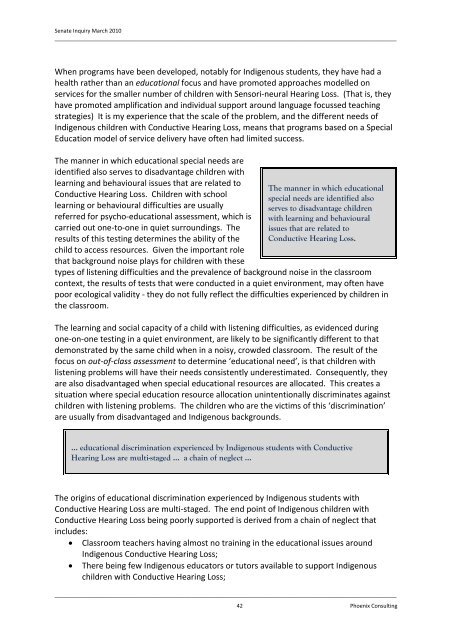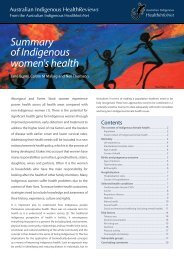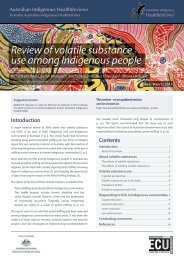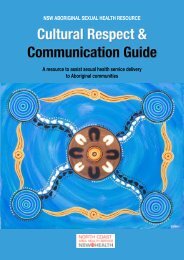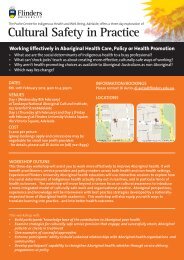hearing loss and the criminal justice system - Australian Indigenous ...
hearing loss and the criminal justice system - Australian Indigenous ...
hearing loss and the criminal justice system - Australian Indigenous ...
You also want an ePaper? Increase the reach of your titles
YUMPU automatically turns print PDFs into web optimized ePapers that Google loves.
Senate Inquiry March 2010_________________________________________________________________________________________________________________When programs have been developed, notably for <strong>Indigenous</strong> students, <strong>the</strong>y have had ahealth ra<strong>the</strong>r than an educational focus <strong>and</strong> have promoted approaches modelled onservices for <strong>the</strong> smaller number of children with Sensori‐neural Hearing Loss. (That is, <strong>the</strong>yhave promoted amplification <strong>and</strong> individual support around language focussed teachingstrategies) It is my experience that <strong>the</strong> scale of <strong>the</strong> problem, <strong>and</strong> <strong>the</strong> different needs of<strong>Indigenous</strong> children with Conductive Hearing Loss, means that programs based on a SpecialEducation model of service delivery have often had limited success.The manner in which educational special needs areidentified also serves to disadvantage children withlearning <strong>and</strong> behavioural issues that are related toConductive Hearing Loss. Children with schoollearning or behavioural difficulties are usuallyreferred for psycho‐educational assessment, which iscarried out one‐to‐one in quiet surroundings. Theresults of this testing determines <strong>the</strong> ability of <strong>the</strong>child to access resources. Given <strong>the</strong> important rolethat background noise plays for children with <strong>the</strong>seThe manner in which educationalspecial needs are identified alsoserves to disadvantage childrenwith learning <strong>and</strong> behaviouralissues that are related toConductive Hearing Loss.types of listening difficulties <strong>and</strong> <strong>the</strong> prevalence of background noise in <strong>the</strong> classroomcontext, <strong>the</strong> results of tests that were conducted in a quiet environment, may often havepoor ecological validity ‐ <strong>the</strong>y do not fully reflect <strong>the</strong> difficulties experienced by children in<strong>the</strong> classroom.The learning <strong>and</strong> social capacity of a child with listening difficulties, as evidenced duringone‐on‐one testing in a quiet environment, are likely to be significantly different to thatdemonstrated by <strong>the</strong> same child when in a noisy, crowded classroom. The result of <strong>the</strong>focus on out‐of‐class assessment to determine ‘educational need’, is that children withlistening problems will have <strong>the</strong>ir needs consistently underestimated. Consequently, <strong>the</strong>yare also disadvantaged when special educational resources are allocated. This creates asituation where special education resource allocation unintentionally discriminates againstchildren with listening problems. The children who are <strong>the</strong> victims of this ‘discrimination’are usually from disadvantaged <strong>and</strong> <strong>Indigenous</strong> backgrounds.… educational discrimination experienced by <strong>Indigenous</strong> students with ConductiveHearing Loss are multi-staged … a chain of neglect …The origins of educational discrimination experienced by <strong>Indigenous</strong> students withConductive Hearing Loss are multi‐staged. The end point of <strong>Indigenous</strong> children withConductive Hearing Loss being poorly supported is derived from a chain of neglect thatincludes: Classroom teachers having almost no training in <strong>the</strong> educational issues around<strong>Indigenous</strong> Conductive Hearing Loss; There being few <strong>Indigenous</strong> educators or tutors available to support <strong>Indigenous</strong>children with Conductive Hearing Loss;_________________________________________________________________________________________________________________42 Phoenix Consulting


